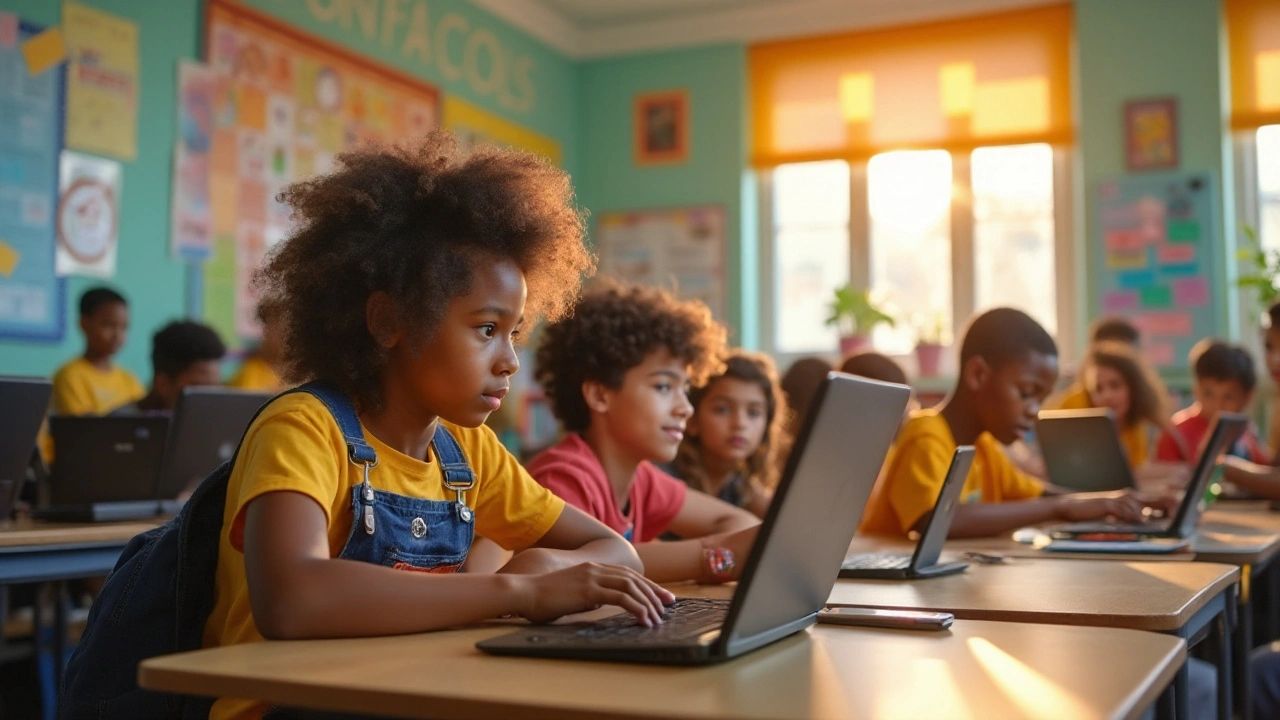Unlock the Secrets of Coding: A Beginner's Journey into Programming

Diving into the world of coding might seem daunting at first, with its unfamiliar symbols and the myth of cryptic complexity surrounding it. However, coding is more like learning a new language, a way for humans to talk to computers and tell them what to do. Just like you’d start with 'hello' when picking up French, there's a starting point in coding too, and it’s often simpler than it looks.
Coding opens up amazing possibilities, letting you create anything from websites to mobile apps, powerful algorithms, or even just automate a task at work. To begin with, it's crucial to grasp the basic concepts and terminologies, akin to first learning the alphabet before writing essays. Our goal here is to demystify these basics and make them feels as normal as chatting with a friend.
Perhaps you've heard of languages like Python, JavaScript, or Java — each has its own quirks and chosen by the pros for different needs. Don’t worry about mastering them all. Instead, familiarize yourself with one that tickles your interest or matches your goals. This way, you’ll be building your coding vocabulary in no time.
- Understanding the Basics
- Popular Programming Languages
- Getting Started with Coding
- Learning Methods and Resources
- Troubleshooting and Debugging
Understanding the Basics
When venturing into the **coding basics**, one might feel like an explorer in uncharted territories. The first step is to understand what coding really is — at its core, coding is simply a method to communicate with machines and instruct them to perform tasks. Imagine a world where you could automate mundane chores or create your own game; coding is the key to unlocking such potential. It is a skill that combines creativity with logic, allowing you to transform ideas into digital reality. Many beginners struggle with the jargon often thrown around in programming circles. Don’t be deterred by terms like variables, functions, and loops. Think of variables as little boxes where data is stored, functions as mini-programs within larger programs, and loops as ways to repeat tasks efficiently until a certain condition is met.
One popular analogy is that learning to code is like learning a new cooking recipe. At first glance, a recipe might seem complex with its ingredients and steps, but with practice, it becomes second nature. Consider a coding language your cookbook, offering syntax and rules similar to a recipe's ingredients and instructions. Python, for example, is renowned for its readability and simplicity, making it ideal for beginners. According to the PYPL Popularity of Programming Language index, Python has been consistently ranked as one of the top programming languages, gaining popularity every year due to its versatility and ease of use. The world of programming languages is vast, yet selecting the right one depends on your goals. Are you interested in web development? Then languages like HTML, CSS, and JavaScript will be your trinity. Alternatively, if data science fascinates you, Python or R might be more suitable.
Breaking Down Key Concepts
Fundamental concepts such as logic and sequencing cannot be overlooked. Computers are not capable of understanding ambiguity, so clarity in coding instructions is crucial. This precision is what makes coding a robust skill applicable across industries; whether you’re developing a website, building a marketing automation tool, or crunching numbers in finance, understanding the logic behind the code is necessary. The control structures you’ll often encounter are foundational to programming. An example is the “if-else” statement, which functions like decision-making in real life, akin to deciding whether to carry an umbrella based on the weather forecast. Laying out your instructions using these structures defines how a computer will execute tasks under certain conditions.“Learning to write programs stretches your mind and helps you think better, creates a way of thinking about things that I think is helpful in all domains.” — Bill Gates
It is also crucial to adopt best coding practices from the beginning. Avoiding bad habits early on can save you hours of frustration later. Writing clean, readable code is a habit worth forming as it aids in debugging — the process of identifying and fixing issues. Commenting on your code as you go helps others (and your future self) understand your thought process. This makes revisiting and tweaking code a lot easier. There’s a common saying in the coding realm: ‘code is read more often than it is written’, reminding us of the importance of clarity and precision. In many cases, collaborative coding in teams makes this principle even more pertinent. As you dive deeper and gain confidence, you'll realize that the true power of coding is not just in its logic but in its ability to bring your imaginative ideas to life.
Popular Programming Languages
When stepping into the coding universe, choosing the right language is like picking the best tool for a crafting project. Each language has its strengths and shines under specific circumstances. One of the leading lights among programming languages is Python, known for its simplicity and readability. Its popularity among beginners and experts alike owes much to how it handles complex tasks with clarity. It’s often the language of choice for data scientists, evidenced by its heavy use in fields like machine learning and data analysis. This is not just hearsay; Python topped the list on the TIOBE index for most popular programming languages in recent years, highlighting its significant foothold in the tech world.
JavaScript is another language that buzzes relentlessly around the web development community. As an essential ingredient of the modern web, JavaScript breathes life into web pages, making them interactive and dynamic. If you’ve ever clicked a button or played a video on a website, JavaScript was likely at work behind the scenes. Its versatility extends to server-side programming, thanks to environments like Node.js, making it indispensable for full-stack developers. For those who dream of sculpting a seamless user experience, JavaScript is hard to pass over.
Then there’s Java, a stalwart in the programming community, famous for its portability and deep-rooted use in enterprise environments. “Write Once, Run Anywhere” is its motto, signifying the language's ability to run on any device without a glitch. It powers a myriad of applications we rely on daily, from enterprise enterprise-level solutions to Android apps. Its robust object-oriented framework makes it a trusty companion for developers venturing into sophisticated software design. Unsurprisingly, Java often features in top ten lists, including Stack Overflow's Developer Survey.
But the world of programming is not limited to these giants alone. Languages like C++, with its powerful control over system resources, appeal to those delving into video game development or high-performance computing. Similarly, Swift is swiftly gaining traction among iOS developers, who are crafting intricate mobile experiences. HTML, while technically a markup language, and CSS deserve a nod, aiding in the creation of the web’s visual landscape.
"Any fool can write code that a computer can understand. Good programmers write code that humans can understand." — Martin Fowler
The choice of language often boils down to personal preferences and specific project needs. No language is inherently superior; the ‘best’ language is what aligns most closely with your goals. For beginners, dipping their toes into coding, starting with Python, can offer a gentle descent into the coding waters. As projects and ambitions grow, exploring the world through Java, JavaScript, and beyond opens up endless possibilities. After all, learning programming is not about mastering every language but choosing the right one that empowers you to solve problems creatively.

Getting Started with Coding
Embarking on your coding journey can be exhilarating, yet often, beginners face a wall of jargon and technical complexity. Fear not, for getting started is about breaking down these barriers and lighting the path to your first line of code. To begin, you need to familiarize yourself with what coding really is – a problem-solving tool and a creative outlet that lets you bring digital ideas to life. The beauty of coding lies in its structured logic, a set of instructions that you tell the computer to execute. Once you understand this, you realize coding is not a beast, but a language you can learn.
The first step is deciding which programming language to start with. Languages like Python are often recommended for beginners due to their simplicity and readability. Python’s syntax feels natural, similar to everyday language, which makes it an excellent choice for those new to coding. On the other hand, if you are interested in web development, you might want to explore JavaScript, the backbone of interactive web pages. Regardless of your choice, commit to mastering one language instead of jumping between different ones.
Setting up your coding environment is the next hurdle. Online platforms like Codecademy or free applications such as Visual Studio Code provide you with all the necessary tools without the need for complex installations. If the terms IDE or text editor sound foreign, think of them as your digital notebooks for writing code. They sometimes come with built-in guides and auto-complete features that are handy for beginners. Once ready, jump right in by writing simple programs – like printing 'Hello, World!' – a rite of passage for every coder.
"Learning to code is not just about gaining coding skills, it's about problem-solving and creative thinking," says an expert from the Institute of Coding.
Don't forget the plethora of resources available at your fingertips. Websites like freeCodeCamp offer comprehensive curriculums, while forums such as Stack Overflow serve as bustling communities for solving coding puzzles and mingling with other learners. Plunge into books like 'Automate the Boring Stuff with Python' that turn mundane tasks into exciting challenges using code and are structured to guide novices to proficiency.
Amidst all the technicalities, maintaining motivation is crucial. Set small goals and celebrate tiny victories, like fixing a bug or understanding a concept. Remember, coding is journey-driven, not destination-focused. It’s more about the learning process than instant success. Keep a log of your progress, whether through a blog, a video diary, or a simple notebook, documenting not just what you learn, but also how you feel navigating this new terrain. These reflections will serve as encouragement on days when the path feels steep.
Learning Methods and Resources
Entering the world of programming can be an exciting journey, full of exploration and discovery. As you begin this adventure, it's essential to understand that there's a wealth of learning methods and resources available to guide you along the way. Whether you're a visual learner, prefer hands-on practice, or thrive on reading theory, there's something out there designed just for you. The best approach often involves combining different methods to reinforce what you've learned and fill in any gaps.
One popular way to start is by taking advantage of online platforms such as Codecademy, Coursera, or Udemy, which offer structured courses on various programming languages. These platforms provide video tutorials, interactive coding exercises, and often, community forums where you can connect with other learners. Some courses are free, while others are paid, but many offer a mix of both options, so you can choose a path that suits your budget. These platforms are a great way to immerse yourself in the coding community and learn at your own pace.
If you're someone who prefers learning from books, there are countless publications available that cater to every level of expertise, from beginner to advanced. Books like "Automate the Boring Stuff with Python" by Al Sweigart or "Eloquent JavaScript" by Marijn Haverbeke are treasures for newcomers and provide comprehensive, engaging insights into coding practices. They not only teach you how to code but also help develop problem-solving skills crucial in the tech world. Reading allows you to digest information slowly and revisit concepts when needed, which is essential for building a solid foundation.
Practical application is key in sound learning, so working on small projects can make a huge difference. Start by creating simple programs or websites, and gradually take on more complex challenges. Websites like GitHub are perfect repositories for finding open-source projects or for viewing code written by experienced developers. By contributing to these projects, you not only refine your skills but also engage with a community of like-minded individuals who can provide feedback and guidance. This collaborative approach encourages growth through experience and connection.
Finally, there's never been a better time to learn to code with communities and coding bootcamps becoming more accessible. These immersive programs can be expensive, but they offer intensive, focused training that accelerates the learning curve. Whether you opt for an online bootcamp or physical classes, they provide a structured environment, real-world projects, and often, job placement support after graduation. Be sure to research various options, checking reviews and outcomes, to find the one that aligns best with your goals. Bootcamps can be intensive, but they're known for producing job-ready developers in a short time.
With these multitude of resources available, finding the right learning path is easier than ever. As author and computer scientist Brian Kernighan once said in his classic work, "The C Programming Language":
"The best way to learn to program is to write programs."
There's truth in these words; as you explore various learning methods and resources, remember the heart of it lies in practice. So embrace the journey, experiment with different approaches, and find what resonates with you. Happy coding!

Troubleshooting and Debugging
Troubleshooting and debugging are indispensable skills in the journey of becoming an adept coder. Like a modern-day detective, you’ll develop an eye for uncovering those pesky bugs and inefficiencies that sneak into your code. It’s important to embrace problem-solving as a fun part of the coding adventure rather than seeing it as a frustrating chore.
Consider this: every time you debug, you build your coding acumen, sharpen your attention to detail, and grow your ability to think like both a human and a computer. Debugging can often feel like untangling a set of Christmas lights, but each step towards clarity teaches patience and resilience. Start by reproducing the error consistently — once you can do this, you’re closer to finding its source. Pay attention to error messages and logs; they’re like clues in a detective novel.
“The key to successful debugging is to stay humble and remain curious about how things work,” advises Linus Pauling, a famed computer scientist.
It's also crucial to have a toolkit for debugging. Begin with visual inspection: analyze your code to spot obvious syntax errors. Then, break down your code into smaller sections to isolate where the problem might lie. Use print statements or a debugger tool to watch variables and see how data changes as your program runs. These methods can illuminate where logic goes astray. Some popular coding environments come with robust debugging tools that allow you to step through your code line by line.
After fixing the bug, it’s wise to understand why it happened in the first place. Reflect on the mistake to avoid repeating it in the future. Discuss your approach with others, because explaining your logic often highlights flaws you hadn’t noticed. Don't shy from asking for help from peers or online communities — collaboration is a powerful resource in troubleshooting. Remember, every coder has faced similar challenges and has valuable insights to share.
Let's glance at some typical errors and strategies to combat them:
- Syntax Errors: Double-check the punctuation and the format of your code.
- Logical Errors: Walk through your code with sample data to verify the logic.
- Runtime Errors: Confirm that all necessary resources and data are available before execution.
In statistics, seasoned programmers spend approximately half of their coding time on debugging, an investment that reaps huge benefits in the long run. Cherish the learning experience every error presents as an opportunity not only to improve your current project but to become a more efficient and confident coder for future challenges.